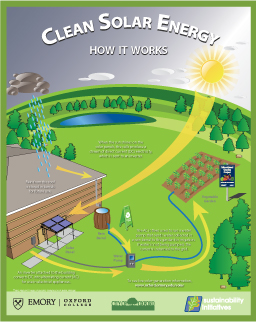Campus News
July 19, 2010
Oxford's new solar panels power campus and beyond

The solar panels include educational signage.
Overwhelming environmental events such as the ongoing Gulf oil spill can make us feel there’s not much we can do to make a difference, but a project recently completed at Oxford College is a reminder that little things can add up.
Following several months of planning, solar panels have been installed on the south side of Oxford’s Haygood Residence Hall. The “why not” idea came first to Theodosia Wade, senior lecturer in biology and a faculty leader for campus sustainability, and it was quickly endorsed by Dean Stephen Bowen and Emory’s Office of Sustainability Initiatives.
The project was right in line with Emory’s goal to reduce energy use 25 percent per square foot by 2015 from 2005 levels. The Office of Sustainability gave the project substantial funding, and additional funds came from Oxford College and the city of Oxford.
During the planning process, Wade decided that it was important to be able to monitor and measure the amount of electricity that would be produced, and Bowen challenged Wade and the group helping her to find a practical use for the setup.Wade’s team met both those requirements. With the help of Oxford’s IT department, they selected an online program that continuously monitors the solar units’ activity. The Haygood location is close to Oxford’s demonstration organic garden, and that provided the practical application. The solar-produced electricity powers a water pump that is used to irrigate the garden with rainwater collected from the Haygood roof. When the pump is not in use, the electricity is sent to the grid.
Except for some nearby information signs, most campus visitors would be hard-pressed to find the solar units. They are so unobtrusive they are often mistaken for an awning for the residence hall.
Unobtrusive does not mean ineffective, however; from their January 2010 installation until June 24, the panels had produced 908 kilowatt hours (as reported by the monitoring software), enough electricity to power one television for 6,311 hours or seven computers for one year or 32 homes for one day.
Compared to electricity generated from fossil fuels, this has avoided production of 2,011 pounds of carbon dioxide, 8.7 pounds of sulphur dioxide and 3 pounds of nitrogen oxides.
Although the front-end effort for the solar project was complex, the in-place reality is simple. With little to no maintenance, Oxford’s solar panels keep at their job every day, providing energy for Oxford and beyond, and making a small but meaningful dent in current environmental challenges.
